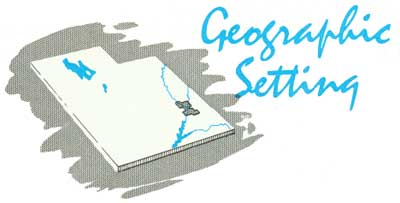
|
Geological Survey Bulletin 1327
The Geologic Story of Canyonlands National Park |
GEOGRAPHIC SETTING

Geologists have divided the United States into many provinces, each of which has distinctive geologic and topographic characteristics that set it apart from the others. One of the most intriguing and scenic of these is the Colorado Plateaus province, referred to in this report simply as the Colorado Plateau, or the Plateau. This province, which covers some 150,000 square miles and is not all plateaus, as we shall see, extends from Rifle, Colo., at the northeast to a little beyond Flagstaff, Ariz., at the southwest and from Cedar City, Utah, at the west nearly to Albuquerque, N. Mex., at the southeast. Canyonlands National Park appropriately occupies the heart of the Canyon Lands section, one of the six subdivisions of the Plateau. As the names imply, the Canyon Lands section of the Plateau comprises a high plateau, generally ranging in altitude from 5,000 to 7,000 feet, which has been intricately dissected by literally thousands of canyons.
Canyonlands National Park is drained entirely by the Colorado and Green Rivers, whose confluence is an important and scenic central feature of the park (figs. 59, 60). Individual canyons traversed or drained by these rivers are discussed in later chapters.
When Major Powell reached the confluence in 1869, the river flowing in from the northeast to join the Green River was called the Grand River, and the Green and Grand joined there to form the Colorado River. The Grand River was renamed Colorado River by act of the Colorado State Legislature approved March 24, 1921, and by act of Congress approved July 25, 1921. But the old term still remains in names such as Grand County, Colo., the headwaters region; Grand Valley, a town 16 miles west of Rifle, Colo.; Grand Valley between Palisade and Mack, Colo.; Grand Mesa, which towers more than a mile above the Grand and Gunnison River valleys; Grand Junction, Colo., a city appropriately located at the confluence of the Grand and Gunnison Rivers; Grand County, Utah, which the river traverses after entering Utah; and Grand View Point, the southern terminus of Island in the Sky.
When viewed at a distance of 1 foot, the shaded relief map (fig. 1) shows the general shape of the land surface in and near Canyonlands National Park to the same horizontal scale as it would appear to a person in a spacecraft flying at a height of 250,000 feet, or about 48 miles. This map was prepared by artist John R. Stacy from parts of the reverse sides of four plastic relief maps2—Salina, Moab, Cortez, and Escalante quadrangles, at a scale of 1:250,000—using a simple time- and money-saving method he devised (Stacy, 1962).
2These plastic relief maps, made by the U.S. Army Map Service, can be obtained from the T.N. Hubbard Scientific Co., Box 105, Northbrook, Ill. 60062. Topographic maps at scales of 1:250,000 and 1:62,500 for the entire area, topographic maps at a scale of 1:24,000 for much of the area, and a special topographic map of Canyonlands National Park and Vicinity" at a scale of 1:62,500 are available from the U.S. Geological Survey, Denver Distribution Section, Federal Center, Denver, Colo. 80225, and from privately owned shops where maps are sold. A revised edition of the latter, including relief shading, will soon be available. An index map of Utah showing all available topographic maps is free up on request to the above address.
An image of Canyonlands National Park and vicinity from a satellite at a height of about 570 miles is shown in figure 7. Note white clouds and black cloud shadows on right.

|
| CANYONLANDS NATIONAL PARK AND VICINITY, from NASA's unmanned Earth Resources Technology Satellite (ERTS-1), at height of about 570 miles. The space image map was prepared from simultaneous scanning in three color bands—blue green, red, and near infrared—that were combined to produce a false-color image in which vigorous green vegetation (forests and irrigated areas) appears bright red, water dark blue, and soils and bare rocks various shades of blue, blue green, or yellow green. Bright-blue area on west bank of Colorado River about 10 miles southwest of Moab is the group of large evaporation ponds of Texas Gulf, Inc., shown in figures 31 and 71. Images were taken at 10:31:10 a.m., Aug. 23, 1972, during the 432d orbit, telemetered to Alaska, videotaped, then photographed. Sun elevation was 53 degrees above horizon from azimuth of 130 degrees. Image covers an area about 100 miles square. (See scale.) Location of Monticello is approximate; that of other towns is believed to be correct. Park boundaries are not shown because of difficulty in locating them accurately, but features such as Colorado and Green Rivers can easily be compared with those in figure 1. (Fig. 7). |
| <<< Previous | <<< Contents >>> | Next >>> |
bul/1327/sec4.htm
Last Updated: 28-Dec-2006